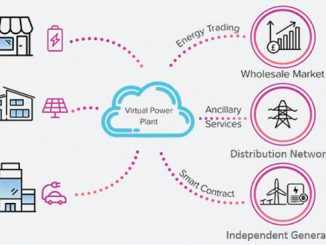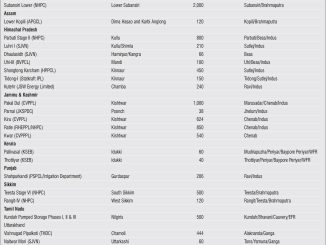
India is a country rich in renewable energy resources that can be utilised for power generation. While a large part of the country receives high solar irradiation, some states have favourable wind speeds. The intermittency issues associated with solar and wind power generation and the limited hours of availability pose problems in grid integration. To overcome these issues and combine the benefits of both sources, there is an emerging interest in wind-solar hybrids. Wind turbines and solar panels can be co-located at good wind sites to result in a higher combined utilisation of renewable energy. Round-the-clock (RTC) power is also being explored by bundling renewable generation with other balancing sources such as thermal power and energy storage.
Renewable energy projects often witness variability in power generation and grid stability. It has been established that hybrid renewable energy systems can reduce this variability, and allow optimal and efficient utilisation of the transmission infrastructure and land. Thus, there have been several developments in the Indian renewable sector on this front.
A look at the key developments, upcoming projects and future outlook for the segment…
Wind-solar hybrids
The wind-solar segment has been evolving and progressing fast. So far, more than 14.7 GW of wind-solar hybrid (WSH) and RTC capacity has been tendered in the Indian market, of which more than 10.4 GW has been allocated. Of the tendered capacity, 11.8 GW is for WSH, of which 7.5 GW has been allocated and is expected to come online by 2023.
To support the development of the segment, the Ministry of New and Renewable Energy (MNRE) released the National Wind-Solar Hybrid Policy in May 2018. The policy provides a framework for the promotion of large-scale wind-solar hybrid projects. As per the policy, these projects may be used as captive plants, for sale to third parties through open access, and for sale to discoms through competitive bidding or at the average power purchase cost under the renewable energy certificate mechanism. In addition to the national policy, states such as Andhra Pradesh and Gujarat came out with state-level policies for WSHs in 2018. Rajasthan also released a wind-solar hybrid policy in 2019 along with its wind power policy. Other states with a promising wind and solar power potential are also contemplating dedicated policies for WSHs.
The overall output from renewable energy projects can be enhanced with the help of complementary generation patterns of wind and solar, along with storage facilities. To this end, guidelines for the procurement of wind-solar hybrid power through the tariff-based competitive bidding (TBCB) process were issued in October 2020. The guidelines provide a framework for the procurement of power from hybrid projects through a transparent bidding process. In a notification issued in August 2021 by the MNRE, the guidelines for TBCB for power procurement from grid-connected WSH projects were amended. The amended guidelines are geared towards addressing issues in implementing large hybrid projects and encouraging investments. They allow discoms to directly procure power from hybrid power generators. This provision will help discoms procure power at a lower tariff by omitting the trading margin to be paid to the Solar Energy Corporation of India (SECI).
SECI has been an active entity in tendering hybrid renewable capacity for development. Since 2018, SECI has tendered five tranches of interstate transmission system (ISTS)-connected WSH projects, of which four have been concluded. Both Tranche I and Tranche II were undersubscribed, primarily due to low tariff caps in the tenders. The tariffs discovered for the first two tranches ranged from Rs 2.67 to Rs 2.69 per kWh. The tariffs have since been falling, with the lowest discovered rate for Tranche III being Rs 2.42 per kWh and the recently concluded auction for Tranche IV resulting in a new low of Rs 2.34 per kWh. The fifth and most recent tranche of 1,200 MW was issued in October 2021.
Among the innovative tenders, SECI also introduced a 1,200 MW tender in August 2019 for WSH projects with storage to supply peak power and another one in March 2020 for 2,500 MW of ISTS-connected blended wind power projects with a wind component of at least 80 per cent. Other than SECI, state agencies, various utilities and companies have also come up with hybrid tenders. These include Adani Electricity, Tata Power, and Maharashtra State Electricity Distribution Company Limited (MSEDCL). In addition to competitive tenders, one of the largest hybrid projects currently in the pipeline is the Gujarat Hybrid Renewable Energy Park located near Vighakot village in Kutch district of Gujarat. Spread over an area of 72,600 hectares, it is expected to have a capacity of 30 GW comprising both solar and wind power. The state government has reportedly allocated land to Adani Green Energy, Sarjan Realities (Suzlon), NTPC, the Gujarat Industries Power Company and the Gujarat State Electricity Corporation for the development of projects in this mega renewable energy park.

Round-the-clock power
Given the increasing demand for RTC power with higher CUFs, SECI has been developing various types of hybrid renewable tenders to make renewable power more despatchable. It issued its first renewable energy tender with a storage component in August 2019 and the first RTC tender in October 2019. The initial auctions concluded with competitive tariffs. In May 2020, ReNew Power won the SECI auction for 400 MW of RTC power at a tariff of Rs 2.90 per kWh.
In March 2020, SECI issued a request for selection of renewable energy developers for the supply of 5 GW of RTC power from renewables bundled with thermal energy. Under this tender, bidders would quote a composite single tariff for renewable energy complemented with thermal energy. Further, in July 2020, the Ministry of Power released the “Guidelines for tariff-based competitive bidding process for procurement of round-the-clock power from grid-connected renewable energy power projects, complemented with power from coal-based thermal power projects”. Later, in November 2020, the ministry amended the guidelines for tariff-based competitive bidding for RTC power projects, adding the provision that renewable projects be bundled with any non-renewable source of energy rather than just thermal power.
This tender was amended a few times, changing the total tendered capacity and reducing it to 2.5 GW from the initial 5 GW. The auction was finally concluded in October 2021 with Hindustan Thermal Projects, Greenko Energies, ReNew Samir Urja, Power Mech Projects and JSW New Energy being declared the winners. The lowest tariff discovered in the auction was Rs 3.01 per kWh, which is a favourably low tariff for bundled power. So far, around 2.9 GW of RTC capacity has been tendered and allocated by SECI through competitive bidding.
Combining thermal power with renewable generation and energy storage is expected to improve grid balancing. By bundling cheaper renewables with expensive thermal power to supply power “round the clock”, a firm supply of power can be achieved to benefit discoms as well as developers.

Outlook
Under the national policy for WSHs, the government had set a target of setting up 10 GW of WSH capacity by 2022. While this seems like a tall target to achieve, if development speeds up, it may be possible to reach the goal – or at least reduce the gap. However, there are significant challenges to overcome. The cost of hybrid power projects is still relatively high, which the low tariffs may not be able to cover. Additionally, bundling with thermal power or adding a storage component increases the levellised cost.
The situation may become more favourable in the coming years when the technology costs of energy storage fall further. With advancements in technology to improve capacity utilisation and lower costs, hybrid power projects are expected to usher in a new era of reliable and affordable renewable power. An increasing share of cost-competitive but intermittent renewable power in the electricity supply mix warrants the deployment of a combination of renewable energy technologies, along with energy storage. Such a mix could be an apt solution for ensuring the stability of the power grid.
By Meghaa Gangahar



